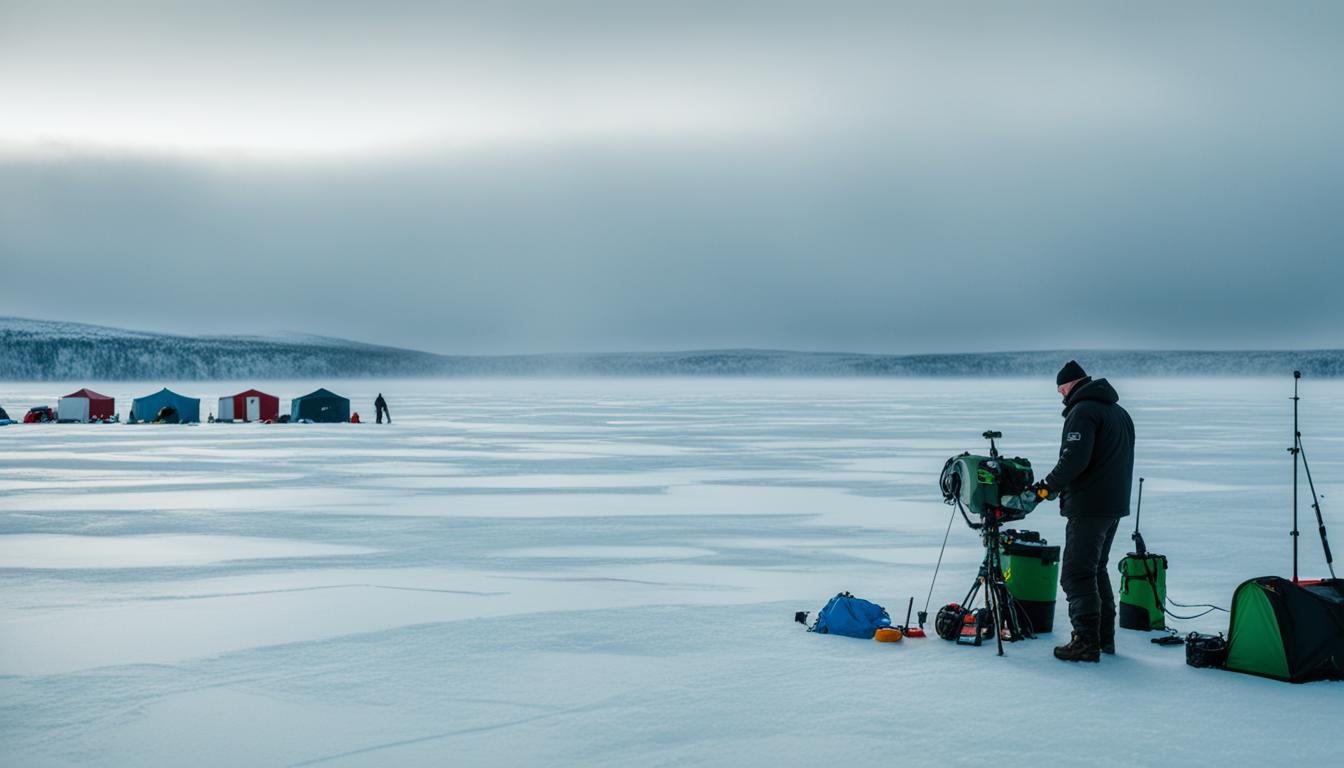Are you ready to venture out onto the frozen lakes and rivers this winter season? Ice fishing offers a unique and thrilling way to access fish during the colder months, but it requires a specific set of techniques to succeed.
In this comprehensive guide, we’ll dive into the expert tips and strategies that will help you make the most of your ice fishing adventures.
Key Takeaways about Ice Fishing Techniques
- Mastering essential ice fishing techniques, such as jigging, deadsticking, and setting up tip-ups, is crucial for success.
- Investing in the right gear, from ice augers and sleds to electronics and safety equipment, can enhance your ice fishing experience.
- Understanding how to locate fish under the ice and target specific species like walleye, pike, and panfish can significantly improve your catch rates.
- Prioritizing safety measures, such as checking ice thickness and wearing proper attire, is paramount for a safe and enjoyable ice fishing expedition.
- Exploring the camaraderie and community aspect of ice fishing can add to the overall enjoyment of the sport.
Whether you’re a seasoned ice angler or new to the sport, this article will equip you with the knowledge and confidence to make the most of the ice fishing season. Let’s dive in and uncover the secrets to becoming a master of the ice!
The Joys of Ice Fishing
Ice fishing offers a thrilling winter adventure that goes far beyond just catching fish. It allows anglers to experience the serene beauty of frozen lakes and rivers, surrounded by the peaceful tranquility of the winter landscape.
The ice fishing camaraderie is unparalleled, as anglers come together to share stories, enjoy warm beverages, and revel in the excitement of a bending tip-up or a furious jigging session. Whether you’re a seasoned pro or a first-time ice angler, embracing the unique challenges and joys of this winter fishing pursuit can make for an unforgettable outdoor experience.
Embrace the Winter Adventure
The frozen lake fishing experience offers a refreshing escape from the monotony of everyday life. Venturing out onto the ice, with the crunch of snow underfoot and the crisp air filling your lungs, can be both invigorating and serene. The opportunity to disconnect from the digital world and immerse yourself in the natural surroundings is a true gift, allowing you to recharge and reconnect with the rhythms of the great outdoors.
Camaraderie on the Frozen Lake
One of the most rewarding aspects of ice fishing camaraderie is the sense of community and camaraderie it fosters. Unlike other fishing disciplines where anglers may be territorial or solitary, ice fishing tends to attract a more social and welcoming crowd.
Anglers often set up their shelters and equipment in close proximity, creating opportunities for sharing information, swapping stories, and enjoying the company of fellow enthusiasts.
The frozen lake becomes a hub of activity, with anglers helping each other, offering advice, and even sharing food and beverages. This social aspect is a cherished part of the ice fishing community experience, making it a fantastic way to bond with friends, family, and newfound fishing companions.
“Ice fishing is not just about catching fish, it’s about the social aspects of ice fishing, the shared experiences, and the memories we create on the frozen lake.”
Dressing for Success on the Ice
Dressing properly is crucial for a comfortable and successful ice fishing experience. The key is to dress in layers, which allows you to adjust your clothing as conditions change throughout the day. Start with a base layer of moisture-wicking synthetic or merino wool fabrics to keep your skin dry.
Follow with insulating mid-layers, such as sweaters, fleece, or puffy jackets, to trap heat. Top it off with a weatherproof outer shell to shield you from wind, snow, and frigid temperatures. This layered approach ensures you can stay warm, dry, and mobile as you navigate the ice and engage in the physical activity of ice fishing.
Layering for Warmth and Mobility
Layering your clothing is essential for staying warm and maintaining mobility during ice fishing. The right combination of base layers, insulating mid-layers, and weatherproof outer layers can make all the difference in your comfort and performance on the ice. By adjusting your layers, you can regulate your body temperature and prevent overheating or getting too cold.
- Base layer: Opt for moisture-wicking synthetic or merino wool fabrics to keep your skin dry and prevent chill.
- Mid-layer: Choose insulating garments like sweaters, fleece, or puffy jackets to trap heat and provide additional warmth.
- Outer layer: Select a weatherproof shell, such as a jacket or bibs, to shield you from wind, snow, and other harsh winter elements.
Footwear and Accessories for Icy Conditions
Protecting your feet is essential for ice fishing comfort and safety. Choose insulated, waterproof boots or boots with built-in crampons to provide traction on the slippery ice. Wool socks will help keep your feet warm and dry.
Consider adding traction aids, such as Yaktrax or ice cleats, to the soles of your boots for added stability and grip. Additionally, don’t forget to pack essential accessories like facemasks, neck gaiters, and insulated gloves to shield your extremities from the harsh winter elements.
| Gear | Importance | Recommendations |
|---|---|---|
| Ice Fishing Boots | Waterproofing and insulation are crucial for keeping your feet warm and dry. | Cabela’s Dura-Trax II Pro boots offer excellent waterproofing and insulation. |
| Socks | Wool socks help wick moisture and maintain warmth, even when wet. | Invest in high-quality Merino wool socks for optimal comfort and performance. |
| Traction Aids | Ensure stability and grip on the slippery ice to prevent falls and injuries. | Yaktrax or ice cleats can be added to boots for enhanced traction. |
| Gloves | Insulated gloves protect your hands from the harsh cold and wind. | Fish Monkey Yeti Premium Ice Fishing Gloves are rated for temperatures as low as -30°F. |
| Facemask/Neck Gaiter | Cover your face and neck to prevent wind chill and frostbite. | Wool or fleece-lined facemasks and neck gaiters provide excellent insulation. |
By investing in the right footwear and accessories, you can stay warm, dry, and secure as you venture out onto the frozen lake. Proper layering and the use of specialized ice fishing gear will help ensure a comfortable and successful ice fishing experience.
Ice Fishing Safety Gear
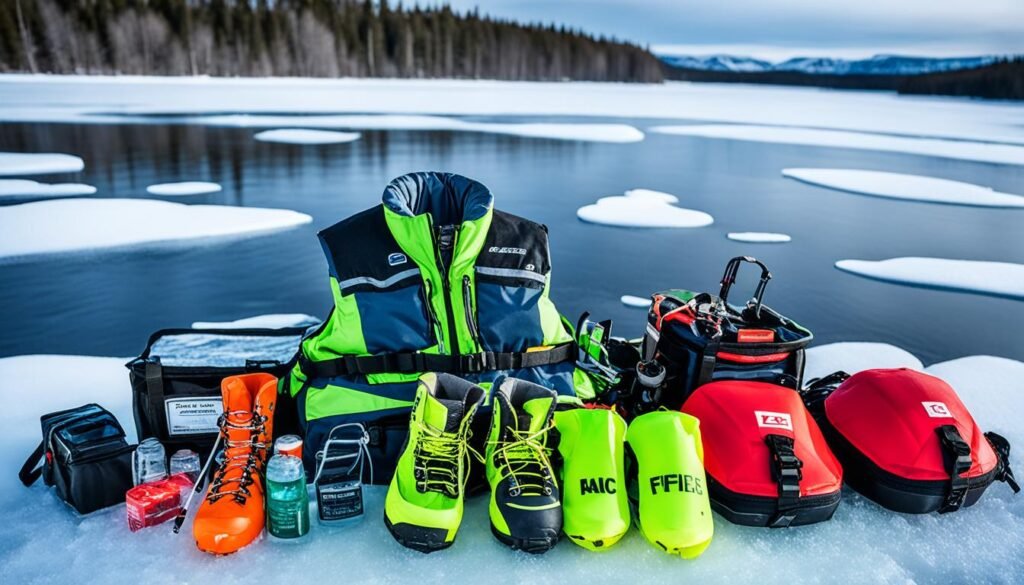
Ensuring your safety should be the top priority when ice fishing. The most essential piece of safety gear is a pair of ice picks or ice claws, which can be used to claw your way out of the water if you were to fall through the ice. These sharp metal spikes, often attached to a cord or retractable reel, should be worn around your neck or secured to your clothing for quick access.
In addition to ice picks, consider wearing slip-resistant traction devices on your boots and packing emergency items like a whistle, flashlight, and dry change of clothes in case of an unexpected plunge into the icy water. Taking these safety precautions will give you peace of mind and help you enjoy your time on the ice with confidence.
Essential Ice Fishing Safety Gear
- Ice picks or ice claws
- Slip-resistant traction devices for boots
- Whistle
- Flashlight
- Dry change of clothes
According to recent statistics, a significant number of ice fishing enthusiasts do not have GPS devices on their snowmobiles, UTVs, or four-wheelers. In such cases, handheld compasses have proven to be reliable in emergencies due to issues with technology. Experienced ice anglers frequently carry safety ice picks around their necks while on the ice, and float suits have become more widely available and improved over the years, enhancing overall ice fishing safety.
Ice cleats are considered essential for providing traction on ice to prevent accidents while drilling holes or walking, and having a spud bar to check ice stability and thickness is recommended for safety precautions. Implementing a float plan and informing someone of your ice fishing location and return time is crucial for rescue operations in case of emergencies.
Situational awareness and common sense are emphasized as key factors in ice fishing safety to avoid hazardous areas and potential risks. By taking the necessary precautions and equipping yourself with the right ice fishing survival gear, you can enjoy the winter adventure on the frozen lake with peace of mind.
Basic Ice Fishing Tools
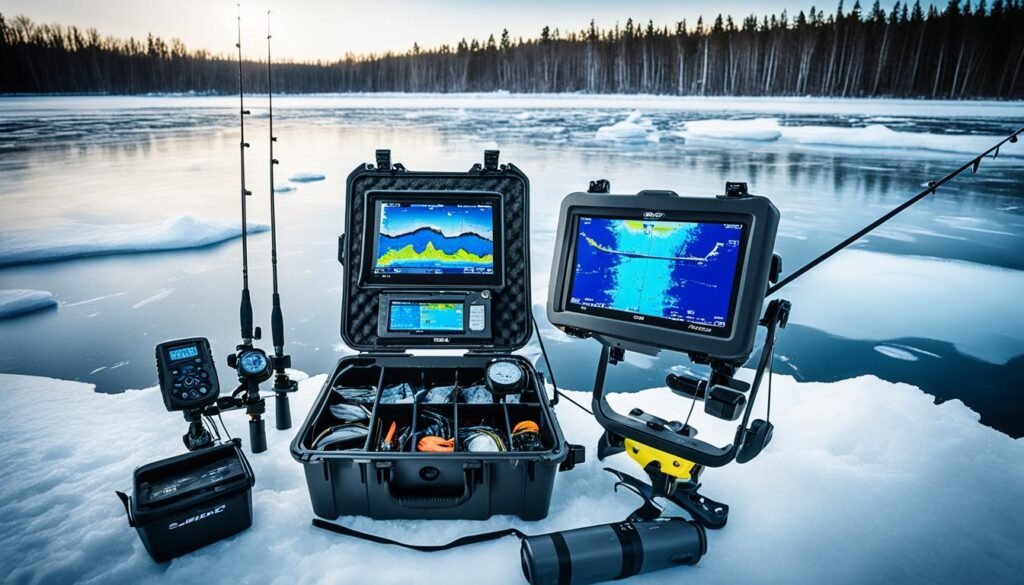
When it comes to ice fishing, having the right tools can make all the difference in your success and comfort on the frozen lake. From reliable ice augers to sturdy ice fishing sleds, these essential pieces of gear are crucial for accessing the fish and transporting your equipment efficiently.
Augers and Sleds
To access the fish beneath the frozen surface, you’ll need a reliable ice auger. These specialized tools, available in manual, gas-powered, or electric versions, allow you to quickly and efficiently drill through the ice. A high-quality ice auger can make the task of creating fishing holes much easier and less physically demanding.
In addition to an ice auger, a sturdy ice fishing sled or cart is invaluable for transporting your gear, such as an ice shelter, rods, bait, and other supplies, out onto the frozen lake. These sleds, often equipped with features like rod holders and storage compartments, help maximize your efficiency and comfort on the ice.
Electronics for Locating Fish
Advancements in ice fishing electronics have revolutionized the ice fishing experience, allowing anglers to more effectively locate and target fish. Portable sonar units, also known as “flashers,” provide real-time information on the depth of the water, the presence of fish, and their activity levels. These devices can be adapted for use on the ice, giving you a significant advantage in finding the best fishing spots.
More advanced ice fishing electronics, such as live-action sonar systems, offer detailed underwater views to help you pinpoint the precise location of fish and make informed decisions about where to set your lines. While a financial investment, these electronic tools can greatly enhance your ice fishing success.
“The right tools can make all the difference in your ice fishing success and comfort on the frozen lake.”
Ice Fishing Techniques
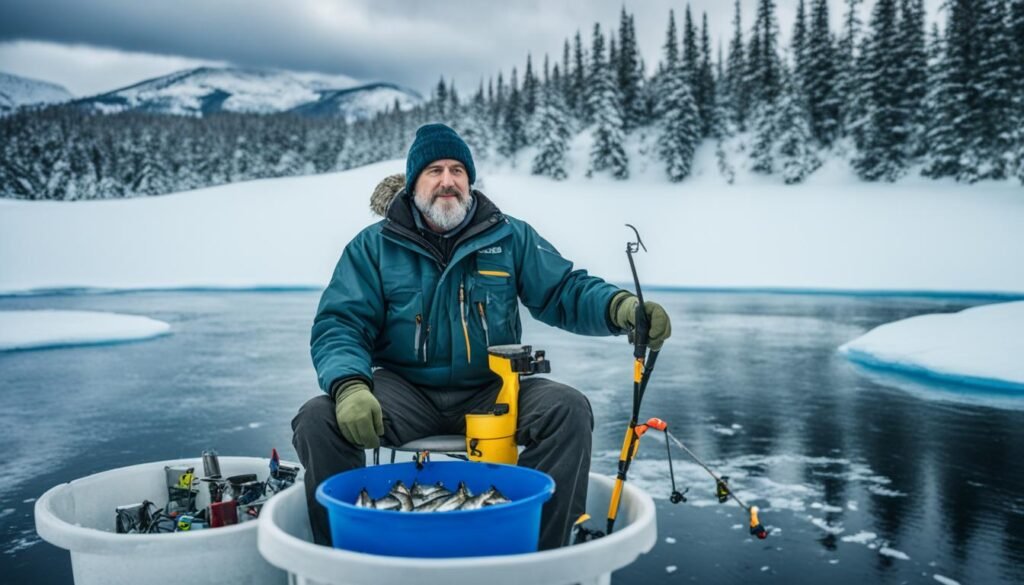
When it comes to ice fishing, two of the most popular and effective techniques are jigging and deadsticking. Jigging involves actively working a lure or bait up and down through the water column, using short, rapid movements of the rod tip to entice fish to strike. This dynamic presentation can be particularly effective for species like walleye, pike, and panfish.
Deadsticking, on the other hand, involves suspending a bait or lure just off the bottom and allowing the fish to come to it. This passive approach can be productive for more lethargic species and can be used in conjunction with tip-ups or other stationary rigs.
Jigging and Deadsticking
Mastering the techniques of jigging and deadsticking can be the key to consistent ice fishing success. Jigging, with its active and dynamic presentation, can be particularly effective for triggering strikes from more aggressive fish. Deadsticking, with its more passive approach, can be productive for lethargic species that may be less inclined to chase down a moving lure. By understanding when to employ each technique, anglers can increase their chances of locating and catching a variety of fish species through the ice.
Tip-ups and Traps
In addition to active fishing techniques, ice anglers often utilize specialized gear known as tip-ups and traps. Tip-ups are devices that suspend a fishing line and bait through the ice, with a small flag that raises when a fish takes the bait. These allow you to monitor multiple lines simultaneously, maximizing your chances of catching fish. Traps, such as jigging rods or tip-downs, are similar setups that use a spring-loaded mechanism to signal a strike. By deploying a network of these stationary rigs, you can cover more water and increase your odds of locating the most productive fishing spots on the ice.
| Ice Fishing Technique | Description | Suitable Species |
|---|---|---|
| Jigging | Actively working a lure or bait up and down through the water column using short, rapid movements of the rod tip | Walleye, Pike, Panfish |
| Deadsticking | Suspending a bait or lure just off the bottom and allowing the fish to come to it | Lethargic species |
| Tip-ups | Devices that suspend a fishing line and bait through the ice, with a small flag that raises when a fish takes the bait | All species |
| Traps | Spring-loaded mechanisms that signal a strike, similar to tip-ups | All species |
“Mastering these techniques and knowing when to employ them can be the key to consistent ice fishing success.”
Choosing the Right Gear
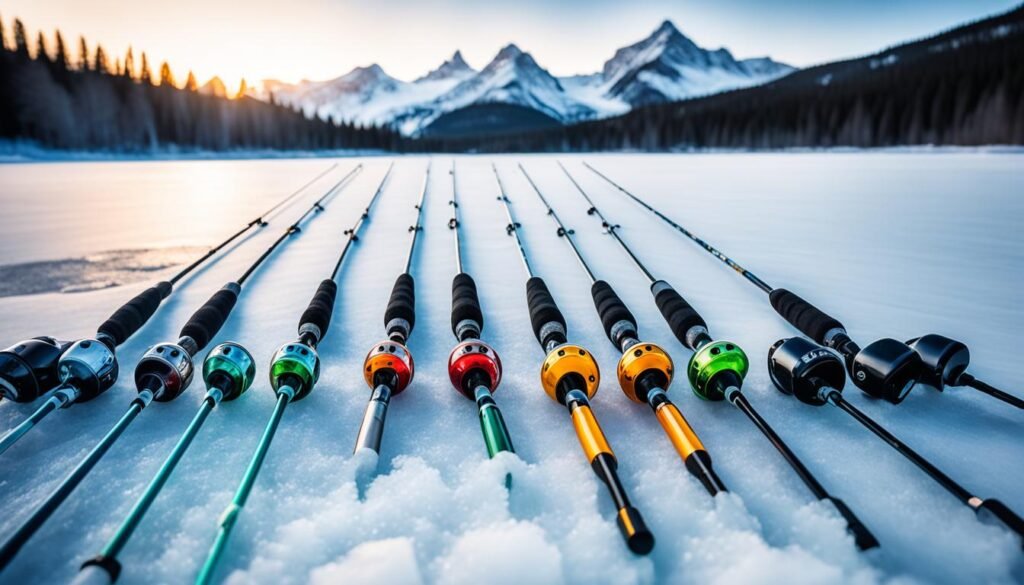
When it comes to ice fishing, selecting the proper equipment can make all the difference in your success on the frozen lake. From ice fishing rods and reels to the right bait and lures, each component of your gear plays a crucial role in your ability to detect, hook, and land fish through the ice.
Rods, Reels, and Line
Ice fishing rods are typically shorter and more lightweight compared to their open-water counterparts, typically ranging from 24 to 36 inches in length. This compact design allows for easy maneuverability and control when fishing through a small hole in the ice. Paired with a smooth-operating, lightweight reel and a sensitive, low-diameter line, your ice fishing rig can be fine-tuned to effectively detect and set the hook on subtle bites.
Brands like Ugly Stik, St. Croix, Fenwick, 13 Fishing, and Tuned Up Custom Rods offer a wide range of ice fishing rod models well-suited for a variety of presentations and target species. For example, Ugly Stik rods, which are priced at around $30, work well for basic jigging, spoon, and lure presentations between 1/16 to 3/8 ounces.
When it comes to line, anglers often prefer copolymer or monofilament options, such as Gamma, to minimize freeze-up. For targeting light-striking crappies and sunfish, 1- to 4-pound-test line is commonly used. For larger species like trophy walleye, pike, or lake trout, braided lines in the 20- to 30-pound range are essential for specialty presentations.
Bait Selection
The choice of bait is crucial when ice fishing, as the cold water and limited forage can make fish more selective in their feeding. Live bait, such as minnows, worms, or larvae, are often the most effective option, as they provide a natural and enticing presentation. When selecting live bait, pay attention to the size and activity level, as smaller, more lively baits tend to work best.
Anglers may also employ a variety of artificial lures, such as ice jigs, spoons, and plastics, which can be equally effective when tipped with a small piece of live bait. Lures like the Glow Streak, Glow Spoon, Rattl’n Flyer Spoon, Rattl’n Quiver Spoon, and Wally Talker are popular choices, each with their own unique jigging techniques and rod requirements.
By carefully selecting the right combination of ice fishing rods, reels, line, and bait, you’ll be better equipped to execute the precise techniques required for successful ice fishing, whether you’re targeting panfish, walleye, pike, or larger predatory species.
Finding the Hotspots
Identifying the most productive fishing locations on the ice is key to consistent success during the ice fishing season. Fish tend to congregate in areas with specific structural features, such as underwater ledges, drop-offs, and submerged weed beds, where they can find ample food and shelter. By using your electronic fish-finding devices, you can map the underwater topography and pinpoint these high-percentage zones.
In addition to utilizing your electronics, pay close attention to signs of fish activity, such as schools of baitfish or the presence of diving birds, as these can indicate the presence of predatory species like walleye, pike, or trout. Thoroughly scouting the ice and experimenting with different depths and locations will help you uncover the most fruitful ice fishing hotspots.
Locating Fish Under the Ice
The behavior of fish under the ice can vary depending on the time of the season. During early ice, fish may be found in shallower waters, taking advantage of remnant green vegetation in the 10-foot range. However, as the season progresses and fishing pressure increases, these fish may be pushed to deeper waters sooner.
To increase your chances of locating fish on the ice, it’s important to diversify your fishing techniques. Use a variety of rod sizes and lure/bait offerings to accommodate the finickiness of the fish. Additionally, pay close attention to the fish behavior under the ice, as they can become easily spooked due to their proximity to the shallow waters and increased activity on the ice.
By combining your electronics, scouting skills, and a versatile approach, you’ll be well on your way to unlocking the most productive ice fishing hotspots and locating fish under the ice. Remember, safety should always be your top priority when venturing out onto the frozen lake.
Ice Fishing for Specific Species
When it comes to ice fishing, successful anglers know that different species require specialized tactics and presentations to target them effectively. By tailoring your techniques to the specific fish you’re pursuing, you can maximize your chances of landing trophy-sized catches through the ice.
Walleye and Pike Tactics
Walleye are known to be more active and aggressive during the winter months, making them an excellent target for ice anglers. Effective walleye tactics often involve jigging with live minnows or aggressive lure presentations to trigger strikes. Pike, on the other hand, can be found lurking near underwater structures and weed lines, waiting to ambush baitfish. Anglers targeting pike may employ tip-ups baited with live suckers or large artificial lures to entice these apex predators.
Panfish and Trout Approaches
In addition to popular gamefish like walleye and pike, ice fishing also provides opportunities to target smaller, but equally exciting species such as panfish and trout. Panfish, including crappie, bluegill, and perch, often school up in specific areas and can be effectively targeted using light tackle and small live baits or ice jigs. Trout, on the other hand, may be found cruising just below the ice surface or suspended in the water column, requiring a more finesse-oriented presentation with sensitive rods and line.
| Species | Preferred Depth | Effective Bait |
|---|---|---|
| Brook Trout | 4-12 feet | Live minnows, worms, lures |
| Lake Trout (Togue) | 15-40 feet | Live smelts, minnows, lures |
| Landlocked Salmon | 0-15 feet | Smelts, shiners, minnows |
| Splake | Varied | Smelts, perch, minnows |
| Brown Trout | Under 15 feet | Live minnows, worms, lures |
| Rainbow Trout | Under 15 feet | Live minnows, worms, lures |
By mastering the nuances of panfish and trout behavior and presentation, you can open up a whole new world of ice fishing possibilities, allowing you to target a diverse array of species throughout the winter months.
“Effective ice fishing for specific species requires understanding their unique behaviors and preferences, and then tailoring your tactics and presentations accordingly.”
Conclusion
Ice fishing in Ontario offers a truly rewarding and unforgettable winter experience for anglers of all skill levels. By arming yourself with the right gear, safety knowledge, and proven techniques, you can unlock the full potential of this captivating cold-weather pursuit. From embracing the camaraderie and serenity of the frozen lake to honing your skills at locating and catching a variety of species, ice fishing provides endless opportunities for adventure, challenge, and an unparalleled connection to the natural world.
Whether you’re a seasoned pro or embarking on your first ice fishing adventure, this comprehensive guide has equipped you with the essential information to make the most of your time on the ice. From dressing for success and mastering crucial safety protocols to selecting the right gear and employing effective fishing strategies, you now have the tools to navigate the icy landscape and reel in your winter catch with confidence.
As you venture out onto the frozen lakes of Ontario, remember to embrace the unique joys and social aspects of ice fishing. Savor the thrill of watching your line spring to life, the satisfaction of outsmarting the fish, and the camaraderie of sharing stories and tips with fellow enthusiasts.
With the right mindset and preparation, ice fishing can become a cherished wintertime tradition, offering a true connection to the great outdoors and a lifetime of memorable experiences.
FAQ about Ice Fishing Techniques
What are some essential ice fishing techniques?
Some of the most effective ice fishing techniques include jigging, deadsticking, utilizing tip-ups and traps, and mastering the use of electronic fish finders and sonar.
What are the benefits of ice fishing beyond just catching fish?
Ice fishing offers a unique winter adventure, allowing anglers to experience the serene beauty of frozen lakes and rivers, and fostering a strong sense of community and camaraderie among ice fishing enthusiasts.
How should I dress for a comfortable and successful ice fishing experience?
Proper layering, with a base layer, insulating mid-layers, and a weatherproof outer shell, is crucial for staying warm and dry on the ice. Investing in the right footwear and accessories, such as insulated boots and traction aids, is also essential.
What are the most important safety considerations when ice fishing?
The most critical safety gear for ice fishing includes ice picks or ice claws, which can be used to claw your way out of the water if you fall through the ice. Wearing slip-resistant traction devices and packing emergency items like a whistle and dry clothes are also important safety precautions.
What essential tools do I need for ice fishing?
The key tools for ice fishing include a reliable ice auger, either manual, gas-powered, or electric, and a sturdy sled or cart for transporting your gear. Advancements in fishing electronics, such as portable sonar units and live-action sonar systems, can also greatly enhance your ice fishing experience.
What are the most effective ice fishing techniques for targeting specific species?
Walleye and pike can be effectively targeted using jigging techniques and tip-ups, while panfish and trout require a more finesse-oriented approach with light tackle and small live baits or ice jigs.
How do I choose the right gear for ice fishing?
When selecting ice fishing gear, it’s important to choose the appropriate rods, reels, and line that are designed for the compact and sensitive nature of ice fishing. The choice of bait, whether live or artificial, can also significantly impact your success on the ice.
How do I locate the most productive fishing spots on the ice?
Identifying key underwater structures, such as ledges, drop-offs, and weed beds, and using electronic fish-finding devices can help you pinpoint the areas where fish are most likely to congregate on the ice.
Source Links
- https://www.themeateater.com/fish/ice-fishing/how-you-can-get-into-ice-fishing-this-winter – How You Can Get into Ice Fishing this Winter
- https://northernontario.travel/sunset-country/beginners-guide-ice-fishing-canada – A Beginners Guide to Ice Fishing in Canada
- https://onthewater.com/ice-fishing-tips-for-beginners – Ice Fishing Tips for Beginners – On The Water
- https://outdoorcanada.ca/what-on-earth-the-essential-ingredient-to-ice-fishing-success/ – What on earth: The essential ingredient to ice-fishing success • Outdoor Canada
- https://www.hatchmag.com/articles/ice-fishing-101/7715428 – Ice fishing 101
- https://northernontario.travel/superior-country/why-ice-fishing-good-soul – Why Ice Fishing is Good for the Soul
- https://deepersonar.com/blogs/us/6-ice-fishing-tips-for-beginners – 6 Ice Fishing Tips for Beginners. The Principles to Success
- https://huntingcase.com/blogs/news/winter-ice-fishing-tips-and-techniques-for-cold-weather-success – Winter ice fishing: tips and techniques for cold-weather success
- https://www.in-fisherman.com/editorial/ice-fishing-essentials-proven-clothing/468073 – Ice Fishing Essentials: Proven Clothing – In-Fisherman
- https://www.themeateater.com/fish/ice-fishing/10-tools-for-staying-alive-while-ice-fishing – 10 Tools For Staying Alive while Ice Fishing
- https://www.brokerlink.ca/blog/ice-fishing-safety-tips – Ice Fishing Safety Tips | BrokerLink
- https://fishncanada.com/fishn-canadas-guide-to-ice-safety/ – Fish’n Canada’s Guide to Ice Safety – Fish’n Canada
- https://www.wired2fish.com/ice-fishing/ice-fishing-essential-gear-guide – Ice Fishing Essential Gear Guide
- https://www.gofishbc.com/learn/fishing-tips/ice-fishing/seven-ice-fishing-essentials/ – 7 Ice-Fishing Essentials – Freshwater Fisheries Society of BC
- https://www.outdoorcanada.ca/expert-ice-fishing-tips/ – 11 basic ice fishing tips • Outdoor Canada
- https://mackslure.com/blogs/mack-attack/ice-fishing-how-to-locate-fish-and-effective-jigging-techniques – Ice Fishing: How to Locate Fish and Effective Jigging Techniques
- https://www.redlakemuseum.com/fish-stories-ice-fishing.html – Fish Stories: Ice Fishing
- https://fishingbooker.com/blog/ice-fishing-the-complete-illustrated-guide/ – How to Go Ice Fishing: The Complete Guide
- https://www.lurenet.com/blog/expert-tips-for-choosing-the-best-ice-fishing-tackle/ – Expert Tips for Choosing the Best Ice Fishing Tackle
- https://ontarioicefishing.net/choosing-the-right-gear-the-essentials-of-ice-fishing/ – Choosing the Right Gear: The Essentials of Ice Fishing – Ontario Ice Fishing
- https://www.outdoorcanada.ca/how-to-pick-the-right-rod-this-winter/ – How to pick the right ice-fishing rod for every situation • Outdoor Canada
- https://www.lurenet.com/blog/6-keys-to-early-ice-fishing-success/ – 6 Keys to Early Ice Fishing Success
- https://northernontario.travel/algoma-country/ice-fishing-perch-tips-target-and-techniques-catch-these-tasty-fish – Ice Fishing Perch: Tips to Target and Techniques to Catch These Tasty Fish
- https://fishncanada.com/top-10-lake-features-to-look-for-when-ice-fishing/ – Top 10 Lake Features to Look For When Ice Fishing – Fish’n Canada
- http://www.maine.gov/ifw/blogs/mdifw-blog/winter-ice-fishing-tips-targeting-specific-species – Winter Ice Fishing Tips for Targeting Specific Species
- https://www.wired2fish.com/ice-fishing/best-ice-fishing-tips-to-get-you-started – Best Ice Fishing Tips to Get You Started
- https://www.in-fisherman.com/editorial/ice-tactics-for-bulging-brown-trout/154656 – Ice Fishing Techniques for Bulging Brown Trout – In-Fisherman
- https://bushlife.ca/ice-fishing-101/ – Ice Fishing 101: A How-To in a Few Simple Steps
- https://ruggedle.com/blogs/news/embracing-the-excitement-of-ice-fishing-a-comprehensive-guide-to-gear-and-techniques – Embracing the Excitement of Ice Fishing: A Comprehensive Guide to Gear
- https://wallybites.com/ice-fishing-need-to-know-survival-tips/ – ICE Fishing – Need to Know Survival Tips !
